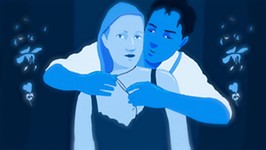Girl Groups: The Story of a Sound
Seldom have obscure footage and recorded memories been put together in so charming a fashion
Reviewed by Stephen MacMillan Moser, Fri., March 2, 2001
GIRL GROUPS: THE STORY OF A SOUND
D: Steve Alpert (1983); with Ellie Greenwich, Jerry Leiber, Mike Stoller, Don Kirschner, Ronnie Spector, Darlene Love, Arlene Smith, with appearances by the Angels, Ronettes, Shirelles, Exciters, Martha and the Vandellas, Supremes, Shangri-Las, Marvelettes, Blossoms, Dixie Cups, and Mary Wells.
Seldom have obscure footage and recorded memories been put together in so charming a fashion. Though somewhat crude and low-budget by today's standards, this documentary is clearly a labor of love -- a love for the sound, the singers, and a time when everyday life seemed a little younger and a lot more innocent. Based on the book of the same name by Alan Betrock, this documentary is a cult classic that pays homage to the last gasp of American rock & roll before it was steamrolled into oblivion by the British Invasion. These were the days of Camelot, when the nation believed in the Kennedy promise, and pop music had a positive, bubblegum sound -- not unlike now, but fresher and more naive. Exhibiting sentiment and endearing dedication, youngsters all over the country idolized such role models as Frankie Lymon, whose youth and irresistible sound inspired legions of pretenders. Ronnie Spector of the Ronettes says, "I knew I wanted to sing, there was no two ways about it, and I wanted to sing rock & roll." Arlene Smith of the Chantals remembers how Frankie inspired her own young career. "When I heard that Frankie was only 13, I said, 'If he can do that…" When the Chantals hit gold with the classic "Maybe," Smith was also only 13. "I was singing about the kind of love I didn't know [about]. I know I loved my parents." The Brill Building on Broadway was Ground Zero for performers and songwriters of the period. Future Earth Mother Carole King began her career in this market by writing such songs as "Will You Still Love Me Tomorrow" for the Shirelles and "Locomotion" for her babysitter, soon to be known as Little Eva. Ellie Greenwich married Jeff Barry and wrote the immortal "Chapel of Love," and Jerry Leiber and Mike Stoller wrote the incandescent "My Boyfriend's Back." Says Leiber of the early days of hitmaking: "We wrote the song, we took it to an artist, we'd rehearse the artist, we'd pick an arranger, Mike would do a skeleton arrangement, we'd go into a studio, the orchestration would fill in the skeleton, we'd record it, we'd mix it, edit it, and put it out." "Nobody cared about money," says Ronnie Spector, a sentiment echoed by Greenwich, the Levittown, Long Island, princess who says, "We were happy just to be making records, to be making money doing something we loved." Says Mary Wilson of the Supremes, "Money was not the important thing -- the important thing was all these people loving us." Needless to say, such a cavalier attitude about financial arrangements came home to roost decades later as these artists and so many more watched as the group's songs became retro hits all over again but they received nothing for it. But while the money and the hits kept rolling in, no one asked questions. Many of them were children, wailing songs of heartbreak and desire, such as "Tell Him" and "You Should Have Seen the Way He Looked at Me" living in a world they were ill-prepared for. Skyscraper hairdos, spackled make-up, and stiletto heels paved the way for their incredible success. But the faces we saw on Shindig and Hullabaloo were only part of the story. Girl Groups shows that behind the acts were the impresarios, such as Berry Gordy, Phil Spector, and George "Shadow" Morton, and the songwriting teams like Jerry Leiber and Mike Stoller, Carole King, Gerry Goffin, and a host of others that created a unique sound that lives among fond memories of decades past.










